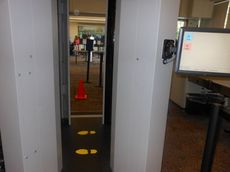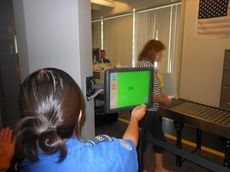
When the Automated Target Recognition Software detects potential threat items on a passenger during screening, a generic outline of a person appears on the monitor highlighting any areas on the passenger that require additional screening.

Passengers will pass through a tube-like portal for the screening. Advanced Imaging Technology safely screens passengers for both metallic and non-metallic threats, including weapons and explosives.

Hands are placed overhead, palms up, for the full body scan. It is reportedly safe for children and pregnant women. Passengers with hip/knee replacements and electronic heart devices are able to pass safely through.

If no anomalies are detected, the text "OK" appears on the monitor with no outline and the passenger is cleared.
Two Advanced Imaging Technology (AIT) safety screens and software, in use at GSP for the past week, were demonstrated in GreerToday. The AIT screens passengers for both metallic and non-metallic threats, including weapons and explosives, without physical contact.
Jon Allen, the Transportation Security Administration (TSA) Public Affairs Manager based in Atlanta, said the AIT bounces harmless electromagnetic waves off of the person to detect items, which may be concealed under a passenger’s clothes. “The electromagnetic wave does not penetrate the skin,” Allen said.
“This technology gives us the best edge to detect metallic and non-metallic anomalies,” Allen said. It is reportedly safe for children and pregnant women. Passengers with hip/knee replacements and electronic heart devices are able to pass safely through.
The AIT’s sensitivity requires everything to be removed that is attached or in a person’s clothing. Allen said he was passing through Raleigh-Durham last week when the AIT detected a quarter he forgot to remove that was deep in his pocket. It will detect folded up paper, wallets, pens and other anomalies through its Automated Target Recognition Software.
There are no alarms or sounds emitted when the software detects an anomaly. A generic outline, identical for all passengers, is visible for the TSA officer and passengers, thus eliminating a TSA officer who viewed the image in a remotely located viewing room. An area will be highlighted by yellow on the monitor when an anomaly is detected. If no anomalies are detected, the text “OK” appears on the monitor with no outline and the passenger is cleared.
“This is a boost for air travel,” Allen said. “We’ve seen a small increase of passenger screening moving faster.” Passengers will still need to remove shoes and belts and go through checkpoint screening as normal. “That is what takes the longest part of the screening process,” Allen said.
Mike Rowley, from Salt Lake City, said he’s been through the process numerous times and welcomes the scan. “People who fly regularly are use to this. If you just empty your pockets and have everything out, there won’t be any problems. As much traveling as I do, I’d rather be safe than sorry.”
Allen said GSP’s installation of the imaging and software technology marks the 14th airport in his six-state region. GSP joins Myrtle Beach, Charleston and Columbia to have this technology at its airports.
There are approximately 730 advanced imaging technology units at more than 190 airports nationwide.